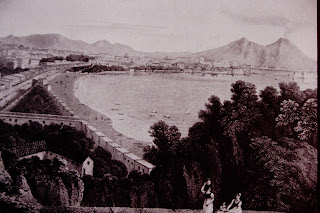The Shelleys
ascended Vesuvius on December 16, 1818. Mary didn’t write much about it in her
journal. Go up Vesuvius and see the
rivers of Lava gush from its sides, she wrote—we are very much fatigued—& S is very ill – return at 10 o’clock—[1]
But a day or
two later, Bysshe left a more detailed account in a very long letter to his
friend Thomas Love Peacock. The Vesuvius portion consumes nearly two full
pages. In it, we learn that he thought it was the most impressive expression of the energies of nature I ever saw—second
only, he said, to the glaciers near Chamonix, France—the Mer de Glace that had occasioned that key scene in Frankenstein.
He and Mary
rode mules to the Vesuvian summit, but Claire Clairmont (yes, she was still
with them) was carried in a chair on the
shoulders of four men, much like a member of parliament after he has gained his
election ….
He describes
the trail, the views, and the thick heavy
white smoke emerging from the crater. He waxes eloquent about the lava and
heat. [T]here are several springs of lava,
he wrote, & in one place it gushes precipitously
over a high crag, rolling down the half melted rocks & its own burning
waves; a cataract of quivering fire.
They stayed
on the summit a while, enjoying the sunset. We
descended by torch light, he tells us.
On the way
down he somehow became ill (a state of
intense bodily suffering) and had some unkind words for their guides—complete Savages, he writes. You have no idea of the horrible cries which
they suddenly utter, no one knows why, the clamour the vociferation & the
tumult.
And Claire
apparently annoyed her carriers, for they
threatened to leave her in the middle of the road …. Only a threat of a
beating changed their attitude.
But then—unexpectedly—these
“savages” began to sing some fragment of
their wild & … sweet national music, the effect is exceedingly fine—[2]
And the
Romantic poet finds Romance in the “savages” of Vesuvius.
I had read
the Shelleys’ and Dickens’ accounts of their ascents before I made my own, and
it probably would have helped if I had read some more current accounts of the
trail to the summit of the mountain that killed Pompeii. But I didn’t. And so I
was a bit nervous about my hike. Could I do it? And—more ludicrously—would the
mountain erupt while I was up there?



No comments:
Post a Comment